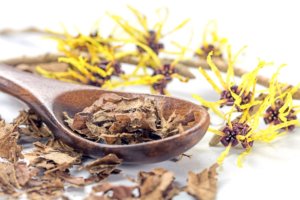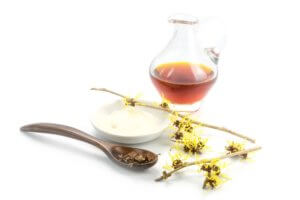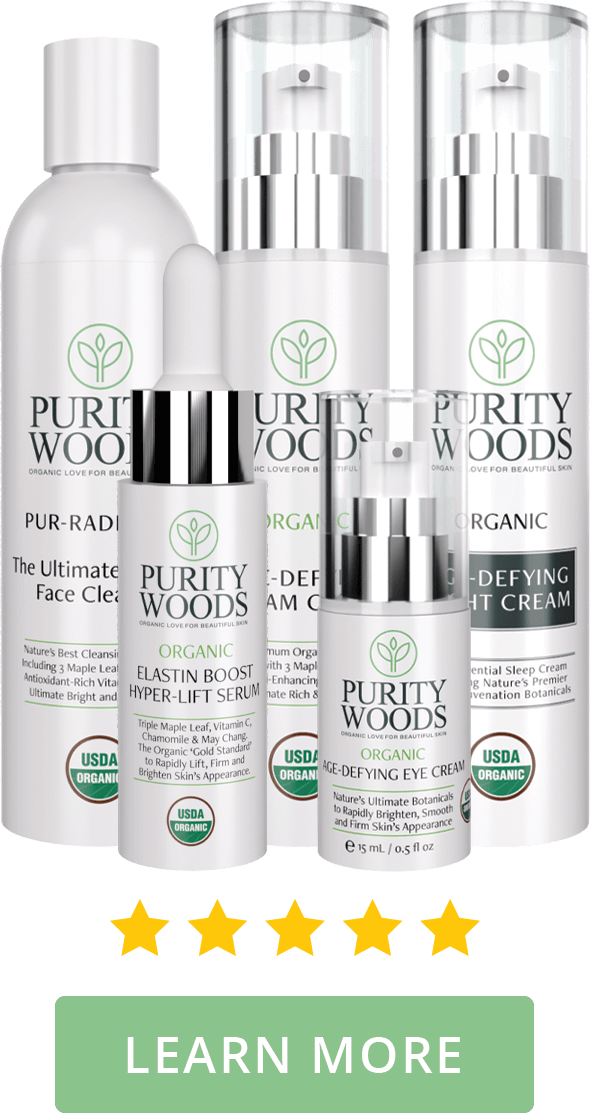Witch hazel is an extremely versatile skincare ingredient. In fact, it has become so popular in toners, creams, cleansers, etc. that it often gets overlooked as just an “ordinary” ingredient, which doesn’t do it justice at all.
Two amazing skin benefits of witch hazel include fighting acne and balancing oily skin. When used as a lotion or hydrosol, it can also calm sensitivity and irritation without drying skin. This should already give you a glimpse of its exceptional versatility.
Here’s more about this natural plant extract and why it has become a staple in skincare.
What is Witch Hazel?
Witch hazel (Hamamelis virginiana) is a shrub native to North America. It’s very unique in the fact that it blooms in October and November, rather than in the spring or summer like most shrubs. This has earned it the nickname ‘winterbloom’.
Native Americans were the first to recognize witch hazel’s medicinal properties. They used it almost as a panacea, including for inflammation and swelling, eye problems, colds, coughs, sore muscles, and dysentery.
Witch hazel also played a big role in spiritual ceremonies and rituals. Different parts of the plant (seeds, branches) were even used as a divination tool.
Though it has a somewhat mysterious name, the word “witch” has nothing to do with spells or cauldrons. It’s thought to be derived from the Old English word wice, which translates as “bendable” or “pliant” (referring to the branches). It could also come from the Middle English word wicke, which translates as “lively” (again referring to the branches).
Turning Witch Hazel into Skincare

For skincare purposes, the bark and twigs of witch hazel are the most powerful parts. In times past, they would be used to make teas, skin washes, and tinctures to treat skin afflictions.
Today, you can use witch hazel on its own as an extract, and you’ll also find it as an ingredient in many skincare products. The extract is typically made through distillation with water and alcohol. There are also alcohol-free versions for those with drier skin.
Witch hazel extract is particularly high in plant compounds known as tannins. This gives it astringent and anti-inflammatory properties, which contribute greatly to its many skin benefits.
For many everyday skin woes, it can be helpful to keep a bottle of witch hazel extract in your cupboard. You can also use it to make your own skincare creations like a toner or natural cleanser.
Of course, if you prefer less work, the best option is to look for a quality, ready-made skincare product that features witch hazel.
Top Skin Benefits of Witch Hazel
Calms Inflammation with Antioxidant Power
Witch hazel is high in a particular group of antioxidants known as polyphenols. Within this group, it’s especially rich in a type of polyphenol known as tannins.
Tannins have many different properties, including antimicrobial activity. A specific tannin in witch hazel, hamamelitannin, is so powerful that is has even shown activity against colon cancer cells in lab studies.
Essentially, this high amount of tannins and other antioxidants is thought to be responsible for the anti-inflammatory power of witch hazel.
When applied to skin, witch hazel can calm inflammation and make your skin look less puffy and irritated. This is true whether you apply it as a pure extract or in a more soothing form, like a lotion. Many people find that it also reduces the puffiness of bug bites and leftover poison ivy. (It won’t stop the itching, though.)
For the most relief, use an alcohol-free version.
Tones and Tightens Skin

Besides acting as antioxidants, the tannins in witch hazel extract also have astringent properties.
The basic definition of an astringent is something that tones tissues and causes them to contract. When it comes to your skin, this means that witch hazel helps your skin look tighter and minimizes pores. It also helps your skin tone to look more even and smooth.
If your skin tends to be more on the oily side, you can use witch hazel extract alone as a toner or combined with a hydrosol. This will give you the maximum astringency for the most toning.
If your skin leans towards the drier side, you’ll probably be better off with an alcohol-free witch hazel. Without alcohol, fewer plant compounds (including tannins) are extracted from the bark AND you’ll avoid the drying effects of alcohol on your skin.
Combats Acne and Oily Skin
With a combination of anti-inflammatory properties and astringency, there are major skin benefits of witch hazel for mild to moderate acne— especially if you have oily skin.
By causing pores to contract, astringents can help to keep acne-causing bacteria out. Many, including witch hazel extract, also have a drying effect on oily skin, which can help to “dry up” certain types of breakouts. Witch hazel without alcohol has more of a balancing effect, cutting down on excess oil without being super drying.
It’s also important to keep in mind that acne is considered an inflammatory skin condition. Naturally reducing inflammation with the antioxidants in witch hazel may minimize breakouts and red patches of skin.
That being said, witch hazel isn’t strong enough to get rid of severe forms of acne. However, it can be combined with stronger treatments in an anti-acne skincare routine.
Soothes Irritation and Redness

A few studies have found that witch hazel can be soothing for sensitive or irritated skin.
Specifically, it has been shown to reduce erythema when used as the active ingredient in a lotion. (Erythema is redness caused by injury or irritation to the skin.) The key concentration seemed to be 10% witch hazel distillate in a carrier lotion.
Other studies have shown similar results for the calming properties of witch hazel, particularly for irritated or sensitive facial skin.
Given the anti-inflammatory nature of witch hazel, it’s very possible that it may also help with issues like dermatitis or eczema. However, this hasn’t been tested yet in clinical studies, so there’s no clear answer.
Calming for Your Scalp
Sometimes we forget that our scalps are part of the rest of our skin. They can develop similar types of issues— itchiness, dryness, redness, sensitivity— and healthy hair starts with a healthy scalp.
The good news is that there are skin benefits of witch hazel for your scalp, too.
When applied as a wash or in a shampoo, witch hazel has been shown to help relieve scalp sensitivity and irritation. It can also reduce redness and ease scalp burn-out (a term that refers to a scalp irritated by hair products, environmental conditions, etc.).
If used in a properly formulated shampoo, witch hazel should be balancing for both oily and dry scalps. It also has cleansing properties that may reduce buildup and keep your hair looking shiny.
Soothing for Sunburn and Razor Burns

Witch hazel isn’t as powerful as aloe vera for burns, but it can help with the superficial type, like sunburns and razor burns.
Basically, it works by calming the redness, irritation, and inflammation that comes with these common skin woes.
To calm red and irritated skin, you can pour witch hazel extract onto a cloth and press it onto your skin. Don’t rub it in or you may irritate your skin further. Just let it “soak” for a few minutes before removing the cloth. You may want to follow the witch hazel up with a moisturizer to keep your skin from drying out.
You can also find an after-sun lotion with witch hazel and simply apply it to the distressed area of skin as needed.
Helps Protect Your Skin from Damage
Many people don’t realize this, but witch hazel has a lot of anti-aging potential. Perhaps most significantly, the antioxidants in witch hazel help to protect your skin from damage that accelerates the aging process.
You’ve probably heard of free radicals, which are unstable molecules that can damage other molecules, including skin cells. This damage increases chronic inflammation in your body and also contributes to the breakdown of important skin proteins like collagen and elastin.
All of this translates to faster skin aging and a complexion that looks prematurely old.
By neutralizing free radicals, antioxidants are able to help prevent this damage from getting out of control. They also help to limit UV damage, which is a big accelerator of free radical formation and skin aging.
Some lab studies have confirmed that the specific antioxidant makeup of witch hazel is active against free radicals and helps to protect skin-related cells. Other research has found that the tannins in witch hazel help improve your skin barrier, which is another layer of protection.
The bottom line: There are likely untapped anti-aging skin benefits of witch hazel that deserve more attention.
May Help Treat Hemorrhoids

Hemorrhoids may not be a common conversational topic, but they are a frustrating health issue to deal with.
In essence, hemorrhoids form due to the swelling and inflammation of veins in the rectal area. They can cause mild symptoms like occasional discomfort, or more severe symptoms like itching and bleeding.
Witch hazel is an old remedy for hemorrhoids and is still considered effective today. It’s even approved by the German Commission E (a scientific advisory board) as an external treatment for hemorrhoids and varicose veins.
The research on witch hazel and hemorrhoids is limited. However, some studies suggest it works by calming inflammation and swelling with its anti-inflammatory, astringent properties. Witch hazel also has hemostatic properties, which may help to stop the bleeding associated with hemorrhoids.
Bonus Benefit: Antiviral Activity
This witch hazel benefit isn’t skin-related, but it deserves a mention to show you just how powerful the extract is.
You’ve already heard tannins mentioned quite a few times in relation to witch hazel. They give the extract anti-inflammatory and astringent properties and help to protect your skin from damage.
Well, the tannins found in witch hazel have also demonstrated significant antiviral properties. They’ve specifically shown activity against influenza A virus and human papillomavirus (HPV). This could very well mean that witch hazel (as a tea or extract) could help your body fight off a viral infection, particularly the flu.
Some test-tube studies have even found that witch hazel extract is active against herpes simplex virus— a common cause of cold sores.
It might be worth dabbing on a little witch hazel the next time a cold sore comes along!
Tips for Choosing a Witch Hazel Product
Because of the numerous skin benefits of witch hazel, you’ll find it available in many forms. You can get it as a pure extract, a skin toner, formulated into a lotion, and so on.
In fact, it comes in so many different products that it may be difficult deciding which one is right for you.
A good starting place is to think about what type of skin you have.
Pure witch hazel extract or a witch hazel toner is often better for oily skin. These both contain the highest amount of tannins that tone skin and reduce oil production. Oily skin can also deal with the addition of alcohol in an extract better than dry skin. (But you should still look for one high on witch hazel with minimal alcohol.)
On the other hand, if you have dry or combination skin, you’ll probably want to go with an alcohol-free witch hazel extract or a witch hazel lotion/cream. These are less drying for skin while still providing you with all the beneficial properties.
No matter what product you choose, always buy USDA Organic when possible to avoid toxins in your skincare. Also, make sure any other ingredients that are combined with witch hazel are natural and/or non-toxic.
Anti-Aging Skincare with Witch Hazel 
If you are looking for anti-aging skincare that makes use of the benefits of witch hazel, Purity Woods has a whole Age-Defying skincare line formulated with organic witch hazel extract.
Each product is formulated with 20+ carefully chosen botanicals (including witch hazel) that quickly erase signs of aging like wrinkles, fine lines, under-eye bags, and saggy-looking skin. All formulas are also USDA Certified Organic, which means no toxins, synthetic chemicals, GMOs, or questionable ingredients.
Try the Age-Defying Dream Cream with elastin-boosting maple leaf extract, the Age-Defying Eye Cream with “the natural retinol alternative” bakuchiol, or the Age-Defying Night Cream with deeply nourishing rosehip seed oil and evening primrose oil.

